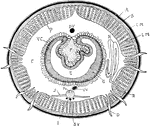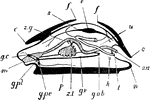Clipart tagged: ‘Nephridium’
Annelid
This diagram shows a fresh-water annelid. a, appendages; br., brain; d, dissepiments; i, intestine;…

Annelid
This diagram shows a transverse section of dero. c., caelom; c.l., cells of the so-called "lateral line";…

Earthworm
"Transverse section of earthworm. A., Cuticle; B., epidermis; C.M., circular muscles; L.M., longitudinal…

Lob Worm
"Dissection of lob-worm from dorsal surface. m., Opening of retracted buccal cavity; i., gullet; gl.,…

Mollusc Parts
"Ideal mollusc. m., Mouth; g.c., cerebral ganglia; c., edges of mantle skirt; z.g., duct of right lobe…

Nephridium
This illustration shows a representation of the circulation of the blood, in its essential features.…

Nereis
A diagram of of the nephridium of Nereis. Nereis is a genus of polychaete worms in the family Nereidae.…

Peripatus Dissection
"Dissection of Peripatus. at., Antennae; or.p., oral papillae; c.g., cerebral ganglia; sl.d., duct of…